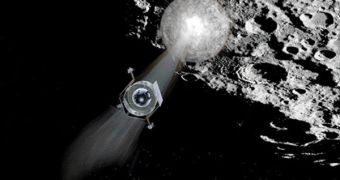This Friday, October 9, could very well represent one of the most historically significant dates in human history. It may be the time when we determine for sure that water-ice reserves exist at the lunar south pole, a find that would have considerable implications for space exploration and for our future among the stars. If water did endure on the natural satellite, regardless of conditions, then it may be possible for it to exist somewhere else as well. And where there is water, life as we know it can exist. Therefore, all eyes and telescopes will be pointed at the Moon this Friday, at 1130 GMT, Space reports.
The Lunar Crater Observation and Sensing Satellite (LCROSS) mission was launched specifically to determine if water-ice indeed existed inside the most remote regions of the Moon, where the Sun did not reach. The LCROSS impactor is equipped with a spent Centaurus rocket stage, which it will drop in the Cabeus crater. It will then photograph the crash site with its instruments, in hopes of determining the light signatures that water-ice generates. Shortly after, the impactor itself will be deorbited and forced to plunge to its destruction inside the same crater. It is estimated that more than 380 tonnes of material will be displaced following the two collisions, a sufficiently large quantity for telescopes to pick up.
“From west of the Mississippi all the way out to Hawaii is in prime viewing conditions. You only need a ten to 12-inch telescope. So it's a really good opportunity for a lot of people to be involved. We're asking anyone who observes the impact to upload their data to us. This may be the largest event that's been observed for a NASA mission in recent memory,” Jennifer Heldmann, an expert at the NASA Ames Research Center, in Moffett Field, California, says. She is also the LCROSS Observation Campaign lead investigator.
The impact will be broadcast live on NASA TV, starting at 1030 GMT on Friday, officials announce. A large number of telescopes will be pointed at the impact site, including some that are in the Earth's orbit. Those on the ground and with a clear shot at the lunar south pole will also take measurements and snap photos. However, spectrometers will be the preferred instruments among scientists, as they can determine for sure the exact composition of the material that is stirred on the Moon.
“Whatever answer we get back, if we see ice or we don't, is going to be significant. So either it's not there, or there's some patchiness and spottiness to it, if it is indeed there. We're going to learn a lot no matter what results are obtained. It has been a lot of work for four minutes of data, but it's a really important four minutes of data. Hopefully, we'll have a variety of data sets that we can combine and make a coherent story. That's the going-in plan,” Heldmann concludes.

 14 DAY TRIAL //
14 DAY TRIAL //